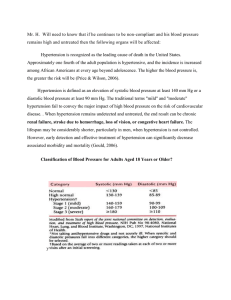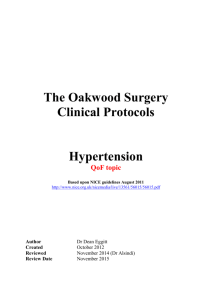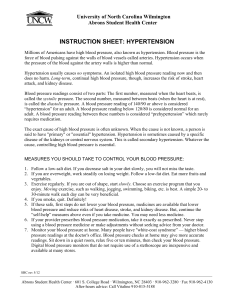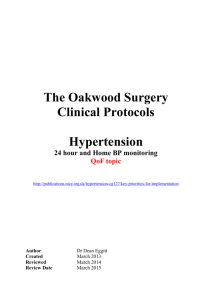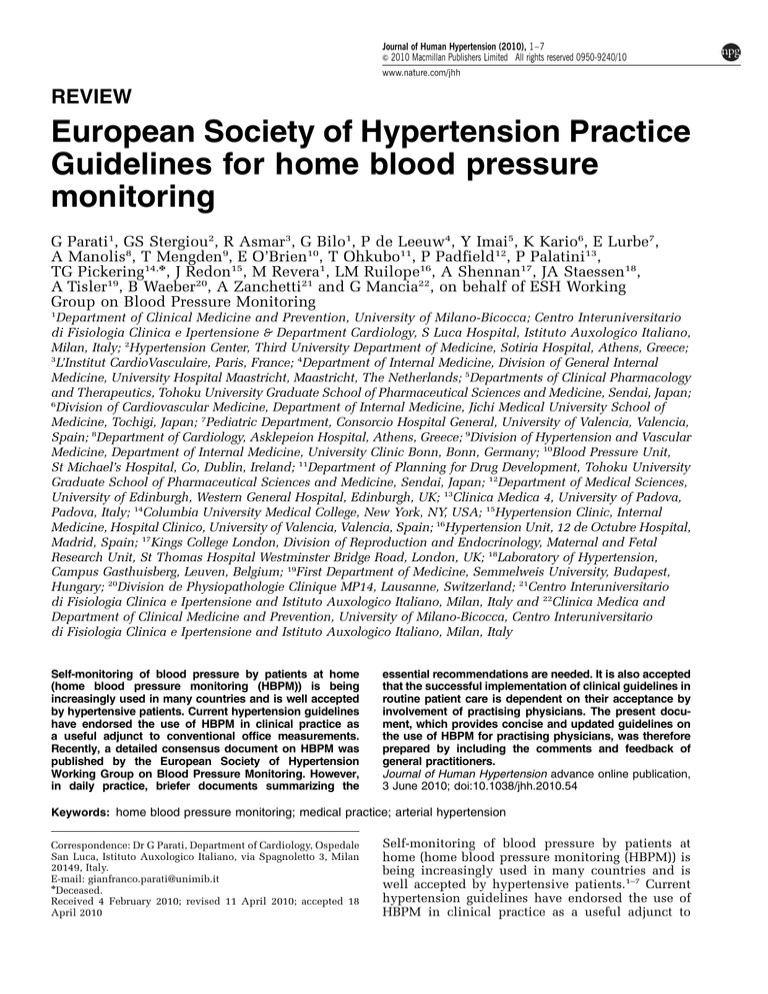
Journal of Human Hypertension (2010), 1–7
& 2010 Macmillan Publishers Limited All rights reserved 0950-9240/10
www.nature.com/jhh
REVIEW
European Society of Hypertension Practice
Guidelines for home blood pressure
monitoring
G Parati1, GS Stergiou2, R Asmar3, G Bilo1, P de Leeuw4, Y Imai5, K Kario6, E Lurbe7,
A Manolis8, T Mengden9, E O’Brien10, T Ohkubo11, P Padfield12, P Palatini13,
TG Pickering14,{, J Redon15, M Revera1, LM Ruilope16, A Shennan17, JA Staessen18,
A Tisler19, B Waeber20, A Zanchetti21 and G Mancia22, on behalf of ESH Working
Group on Blood Pressure Monitoring
1
Department of Clinical Medicine and Prevention, University of Milano-Bicocca; Centro Interuniversitario
di Fisiologia Clinica e Ipertensione & Department Cardiology, S Luca Hospital, Istituto Auxologico Italiano,
Milan, Italy; 2Hypertension Center, Third University Department of Medicine, Sotiria Hospital, Athens, Greece;
3
L’Institut CardioVasculaire, Paris, France; 4Department of Internal Medicine, Division of General Internal
Medicine, University Hospital Maastricht, Maastricht, The Netherlands; 5Departments of Clinical Pharmacology
and Therapeutics, Tohoku University Graduate School of Pharmaceutical Sciences and Medicine, Sendai, Japan;
6
Division of Cardiovascular Medicine, Department of Internal Medicine, Jichi Medical University School of
Medicine, Tochigi, Japan; 7Pediatric Department, Consorcio Hospital General, University of Valencia, Valencia,
Spain; 8Department of Cardiology, Asklepeion Hospital, Athens, Greece; 9Division of Hypertension and Vascular
Medicine, Department of Internal Medicine, University Clinic Bonn, Bonn, Germany; 10Blood Pressure Unit,
St Michael’s Hospital, Co, Dublin, Ireland; 11Department of Planning for Drug Development, Tohoku University
Graduate School of Pharmaceutical Sciences and Medicine, Sendai, Japan; 12Department of Medical Sciences,
University of Edinburgh, Western General Hospital, Edinburgh, UK; 13Clinica Medica 4, University of Padova,
Padova, Italy; 14Columbia University Medical College, New York, NY, USA; 15Hypertension Clinic, Internal
Medicine, Hospital Clinico, University of Valencia, Valencia, Spain; 16Hypertension Unit, 12 de Octubre Hospital,
Madrid, Spain; 17Kings College London, Division of Reproduction and Endocrinology, Maternal and Fetal
Research Unit, St Thomas Hospital Westminster Bridge Road, London, UK; 18Laboratory of Hypertension,
Campus Gasthuisberg, Leuven, Belgium; 19First Department of Medicine, Semmelweis University, Budapest,
Hungary; 20Division de Physiopathologie Clinique MP14, Lausanne, Switzerland; 21Centro Interuniversitario
di Fisiologia Clinica e Ipertensione and Istituto Auxologico Italiano, Milan, Italy and 22Clinica Medica and
Department of Clinical Medicine and Prevention, University of Milano-Bicocca, Centro Interuniversitario
di Fisiologia Clinica e Ipertensione and Istituto Auxologico Italiano, Milan, Italy
Self-monitoring of blood pressure by patients at home
(home blood pressure monitoring (HBPM)) is being
increasingly used in many countries and is well accepted
by hypertensive patients. Current hypertension guidelines
have endorsed the use of HBPM in clinical practice as
a useful adjunct to conventional office measurements.
Recently, a detailed consensus document on HBPM was
published by the European Society of Hypertension
Working Group on Blood Pressure Monitoring. However,
in daily practice, briefer documents summarizing the
essential recommendations are needed. It is also accepted
that the successful implementation of clinical guidelines in
routine patient care is dependent on their acceptance by
involvement of practising physicians. The present document, which provides concise and updated guidelines on
the use of HBPM for practising physicians, was therefore
prepared by including the comments and feedback of
general practitioners.
Journal of Human Hypertension advance online publication,
3 June 2010; doi:10.1038/jhh.2010.54
Keywords: home blood pressure monitoring; medical practice; arterial hypertension
Correspondence: Dr G Parati, Department of Cardiology, Ospedale
San Luca, Istituto Auxologico Italiano, via Spagnoletto 3, Milan
20149, Italy.
E-mail: gianfranco.parati@unimib.it
{
Deceased.
Received 4 February 2010; revised 11 April 2010; accepted 18
April 2010
Self-monitoring of blood pressure by patients at
home (home blood pressure monitoring (HBPM)) is
being increasingly used in many countries and is
well accepted by hypertensive patients.1–7 Current
hypertension guidelines have endorsed the use of
HBPM in clinical practice as a useful adjunct to
Home blood pressure monitoring
G Parati et al
2
the conventional office measurements.1–7 In 2008 a
detailed consensus document on HBPM was published by the European Society of Hypertension
Working Group on Blood Pressure Monitoring.1
However, in daily practice, briefer documents summarizing the essential recommendations are needed.
It is also accepted that the successful implementation of clinical guidelines in routine patient care
is dependent on their acceptance by involvement of
practising physicians. Therefore, this practice guidelines document on HBPM use was prepared by
including the comments and feedbacks of two groups
of general practitioners (see Acknowledgements).
HBPM: advantages—prerequisites
HBPM has several major advantages over conventional office blood pressure (BP) measurement: (1) it
provides multiple measurements of BP in different
days, weeks or months; (2) these measurements are
made in the usual environment of each individual,
away from the physician’s office, a setting known to
cause a BP increase in many subjects (white-coat
effect); (3) home BP is more closely related to
hypertension-induced target organ damage and
predicts the risk of cardiovascular events better
than conventional office measurements (Boxes 1
and 2). HBPM can detect the white-coat and masked
hypertension phenomena, and it shares most of the
above features with 24-h ambulatory BP monitoring
(ABPM), another important technique for out-ofoffice BP monitoring (Box 1).1–4 Compared with
ABPM, HBPM provides measurements over a much
longer period, is cheaper, more widely available,
more convenient for patients particularly for repeated measurements, and has been shown to
improve patients’ compliance with treatment and
hypertension control rates.1–4,8 However, unlike
ABPM it does not allow the assessment of BP during
sleep or at work, or the quantification of short-term
BP variability, although it may be possible to assess
day by day BP variability,9,10 thus offering a means to
quantify long-term BP variations which, as recently
suggested, may have prognostic significance.11
Moreover, HBPM can be used as an educational tool
in hypertensive patients for improving the understanding of their disease and its follow-up. Thus, it
seems to be an appropriate method for the long-term
follow-up of treated hypertension and is often used
in conjunction with ABPM as a complementary
method of BP assessment (Box 1).
There are important prerequisites for the optimal
application of HBPM in clinical practice (Box 2).
HBPM should be performed by patients who have
been trained under medical supervision, and trained
nurses and/or pharmacists can have an important
part in the implementation of HBPM in daily practice
and in the diffusion of correct recommendations.
Box 2 Key issues related to the methodology of HBPM
Medical supervision and patient training (see online
Supplementary Material).
Appropriate choice of validated HBPM devices. Specific
validation required in special populations (elderly, children,
normal pregnancy, pre-eclampsia, end-stage renal disease and
arrhythmias).
Adequate blood pressure measurements schedule and data
reporting by patient.
Ability of physician to interpret the results correctly
(averaging of values and normal thresholds).
Abbreviation: HBPM, home blood pressure monitoring.
Box 1 Summary of advantages and limitations of HBPM (modified with permission from Parati et al.1)
Advantages
Limitations
A number of measurements of blood pressure and heart rate
during the day and also over several days, weeks or months are
possible.
Assessment of treatment effects at different times of the day and
over extended periods.
No alarm (white-coat) reaction to blood pressure measurement.
Diagnosis of white-coat and masked hypertension.
Need of patient training (simple for automated devices).
Good reproducibility.
Good prognostic value.
Relatively low cost.
Patient-acceptance.
Education tool—involvement of patients in hypertension
management.
Possibility of digital storage, printout, PC download or
teletransmission of blood pressure values (some devices).
Improvement of patients’ compliance to drug treatment.
Improvement of hypertension control rates.
Abbreviation: HBPM, home blood pressure monitoring.
Journal of Human Hypertension
Possible use of inaccurate devices.
Measurement errors.
Questionable reliability of blood pressure values reported by
patients.
Induction of anxiety, resulting in excessive monitoring.
Risk of treatment changes made by patients on the basis of
casual home measurements without doctor’s guidance.
Normality thresholds and therapeutic targets still debated,
mainly in patients at high cardiovascular risk.
Lack of night-time recordings.
Absence of reimbursement by insurance company or social
security in most countries.
Home blood pressure monitoring
G Parati et al
3
Training should include information regarding hypertension, BP variability, conditions and procedure
for self-monitoring, advice on equipment choice
(based on validation, technical features, price and
individual experience) and its proper use, and interpretation of results (see Supplementary material).
The HBPM technique, when applied using electronic
devices, is not particularly complex and can be
explained to the patient during a single training
session (possibly with subsequent periodic verification of correct monitoring performance during office
visits). However, in some patients (in particular
the elderly with motor or cognitive impairment
and in young children), the support of a trained
nurse or family member may be needed. Telephonic
assistance for patients having doubts or problems
with correct HBPM performance may prove to
be useful. A standardized BP logbook structured
according to the required monitoring schedule is
useful for ensuring the accuracy of data reporting
and for improving adherence to measurements
schedule (see Supplementary material). Manufacturers can facilitate HBPM by providing devices
with a range of cuffs for varying arm sizes and
capable of automatically calculating average BP. The
provision of telemonitoring facilities may be of
further advantage.12
Devices and cuffs
The conventional mercury sphygmomanometer,
regarded as the gold standard for BP measurement,
is being progressively banned in several countries
for environmental reasons (Box 3). Aneroid devices
are more prone to inaccuracy than mercury devices.1,2,4 Moreover, patients only rarely master the
auscultatory technique required for using these
devices. Therefore, except for special cases (for
example, patients with arrhythmias trained in
auscultatory BP measurement) the use of auscultatory devices (mercury, aneroid or other) is not
recommended for HBPM.
Semi-automated (manual cuff inflation) or automated electronic devices that measure BP at the
level of the upper arm are preferred for HBPM.1–5
These devices require less training, avoid observer
bias, and, if equipped with an automated memory,
have the potential to prevent patients from misreporting their BP measurements.13,14
Finger devices are less accurate and more susceptible to flaws in measurement technique and are not
recommended. Wrist devices are not recommended,
because they are more subject to inaccuracies
(incorrect position in relation to the heart, measurement of BP in two arteries—radial and ulnar,
peripheral pulse wave distortion, and so on), and
are best avoided, unless brachial measurements are
difficult or impossible to obtain (for example, in
subjects with very large arm circumference or
extreme obesity).1,2,4
Box 3 Devices for HBPM
Only validated semi-automated or automated oscillometric
(electronic) arm cuff devices are recommended.
Devices with memory are preferred.
Auscultatory (aneroid or mercury) devices are not
recommended except under specific circumstances (for
example, arrhythmia, requiring repeated auscultatory
measurements).
Finger cuff devices not recommended.
Wrist cuff devices are not recommended at present, yet possible
applications are still under investigation, as in the case of
patients in whom brachial BP measurements are impossible
or very difficult (for example, extreme obesity).
Appropriately sized (small, standard or large) cuffs should be
used according to arm circumference.
Abbreviation: HBPM, home blood pressure monitoring.
Among the large number of HBPM devices
available on the market only those that have been
validated for accuracy in independent studies
performed according to internationally recognized
protocols should be used.15,16 Up to date lists of
validated devices are available at the dedicated
websites (for example, www.dableducational.org,
www.bhsoc.org and www.pressionearteriosa.net).
It should not be assumed that a device that has been
validated in the general population will be accurate
in special circumstances, such as obesity, patients
with arrhythmias, older age, children or pregnancy
in which devices should be specifically validated.
The selection of the appropriate size of the cuff to
fit the arm of each individual is essential for an
accurate BP measurement (the inflatable bladder of
the cuff should cover 80–100% of the individual’s
arm circumference).1,2,4 The use of a small cuff for
the size of the arm can result in overestimation of
BP, whereas a too large one in its underestimation.
Although standard cuffs are appropriate for most
patients, in those with small (o24 cm) or large
(432 cm) arm circumference only the devices
equipped with appropriate sized cuffs should be
used.
Conditions of measurement
Conditions under which HBPM is performed can
greatly affect the measured BP levels (Box 4). The
cuff should be wrapped around the arm with its
inflatable bladder centred on the arm anterior
surface (most cuffs have an indication of proper
placement) with the lower edge of the cuff approximately 2–3 cm above the bend of the elbow. The
bladder should be positioned at the heart level
(particular attention must be paid to this recommendation if, for any reason, a wrist device is used).
The measurement should be performed in a quiet
room and the patient should remain seated comfortably, immobile with the arm resting on a table or
other support and should not talk. The results
should be reported in a logbook immediately after
each measurement. Alternatively, memory equipped
Journal of Human Hypertension
Home blood pressure monitoring
G Parati et al
4
Box 4 Conditions of measurement
Box 5 Monitoring schedule
At least 5-min rest, 30 min without smoking, meal, caffeine
intake or physical exercise.
Seated position in a quiet room, back supported, arm supported
(for example, resting on the table).
Subject immobile, legs uncrossed, not talking and relaxed.
Correct cuff bladder placement at heart level.
Results immediately reported in a specific logbook or stored
in device memory.
Seven-day home measurements (minimum 3 days).
At initial assessment, when assessing treatment effects, and in
the long-term follow-up before each clinic/office visit.
Morning (before drug intake if treated) and evening (before
eating) readings per day.
Two measurements per occasion (1–2 min apart).
Long-term follow-up: less frequent measurements (for example,
once or twice per week) could be regularly performed aimed
at reinforcing compliance, although isolated readings should
never be used for diagnostic purposes.
Overuse of the method and self-modification of treatment
should be avoided.
devices, which are recommended, can store the
readings with time and date for each measurement.
Sometimes devices are used to measure BP in other
family members and it is important to ensure that
these are not included with a patient measurement.
In rare cases of significant (410 mm Hg) and consistent BP difference between arms, the physician
should advise the patient to use the arm with higher
BP values also for HBPM.
Monitoring schedule
For the initial evaluation of hypertension and the
assessment of the effects of antihypertensive treatment (including changes in drug or dose) HBPM
should be performed daily during at least 3 and
preferably 7 days before the doctor’s visit (Box 5).
Duplicate measurements should be obtained in the
morning (before drug intake if treated) and in the
evening.17 Measurements of the first monitoring day
are usually higher and unstable and are excluded.
Treated hypertensive patients may also perform less
frequent, regular home BP measurements as a longterm follow-up (for example, once or twice per
week), with the additional aim to reinforce their
compliance with treatment. However, this issue is
still matter of debate and isolated readings should
never be used for diagnostic purposes.1–4 Overuse of
the method and self-modification of treatment on
the basis of HBPM should be avoided.
Interpretation of HBPM
The average of a series of measurements taken as
described above should be used for the clinical
decisions based on HBPM readings (Box 6). Casual,
isolated home measurements can be very misleading
and should not by themselves constitute the basis
for clinical decisions. The users should be informed
that BP may vary between measurements and be
instructed not to be alarmed by high or low BP
measured on a single occasion, unless an important
elevation or reduction persists or is associated with
symptoms of clinical relevance (for example, dyspnoea, chest pain). Average systolic home BP
X135 mm Hg and/or diastolic X85 mm Hg indicates
elevated BP. The levels of ‘normal’ and ‘optimal’
home BP are still under investigation, provisionally
suggested values being o130/80 mm Hg for normal
home BP.1–4,18 Therapeutic decisions based on home
Journal of Human Hypertension
Box 6 Interpretation of home BP readings
Average BP from several monitoring days should be considered
(for schedule see Box 5).
BP values measured on the first monitoring day should be
discarded.
Mean home systolic BP X135 mm Hg and/or diastolic
BPX85 mm Hg should be considered as elevated.
Systolic and diastolic home BP o130 and o80 mm Hg,
respectively, should be considered normal in most subjects.
In high-risk subjects home BP targets should probably be lower.
Abbreviation: blood pressure.
monitored BP should always take into consideration
overall cardiovascular risk profile and comorbidities. In high-risk subjects (for example, those with
diabetes or chronic kidney disease) lower home BP
values should probably be achieved but the targets
have not yet been defined.
Discrepancies between home and office BP
In the majority of patients, HBPM will lead to the
same clinical conclusion regarding the diagnosis of
hypertension as the conventional office measurements (normotension or controlled hypertension if
both are normal; uncontrolled hypertension if both
are elevated). However, cases of disagreement in
diagnosis between office and home (or ambulatory)
BP measurements are not uncommon in both
untreated and treated subjects. Elevated BP in the
office with low home (or ambulatory) BP is known
as ‘white-coat’ (or ‘isolated office’) hypertension.
Conversely, normal BP in the office with elevated
home (or ambulatory) BP has been termed masked
hypertension.1–4,19–21 These diagnostic conclusions
should be reinforced by performing further investigations including repeated office BP measurements
and either a repeated session of HBPM or a 24-h
ABPM.4,19,22
Subjects with white-coat hypertension are at a
marginally increased cardiovascular risk and also
at an increased risk to develop sustained hypertension.4,22 Therefore, they should be regularly
followed using office and home BP measurements.
On the other hand masked hypertension is associated
with increased risk of cardiovascular events, similar
Home blood pressure monitoring
G Parati et al
5
to that of uncontrolled hypertension.23 Given this
between-method discrepancy, treatment decisions
in white-coat and masked hypertension should
probably be made on the basis of both office and
out-of-office BP measurements (the latter through
ABPM or HBPM, provided that they are reliable
and have been repeatedly performed), always taking
into account the patient’s total cardiovascular risk
profile.1,2,4
Clinical indications for HBPM
Given the fallibility of conventional office BP measurements, HBPM provides clinically useful information
on BP level and profile to practising doctors, because
it enables a more precise initial diagnosis of hypertension and more accurate titration of antihypertensive
drug treatment (Box 7). It also offers useful information on home heart rate24 and on day-by-day BP
variability.9,10 Therefore, if feasible, it should be used
in all treated hypertensive patients. Its use is also
recommended for the identification of patients with
suspected white-coat or masked hypertension, (particularly among subjects with borderline or highly
variable office BP, high cardiovascular risk and normal
office BP, hypotension symptoms in spite of inadequate office BP control by treatment, no signs of organ
damage in spite of the high office BP).23,25,26 HBPM is
further recommended in patients with poor compliance with treatment (HBPM may increase their
involvement in hypertension management), and possibly also in some high-risk populations in whom close
BP control is mandatory (pregnant women, renal and
diabetic patients). In pregnancy, HBPM should be
performed with devices validated in this condition and
available evidence suggests that the diagnostic thresholds should be the same as in the general population,
although more studies are needed on this issue.
A contraindication for HBPM performed with
oscillometric devices is the presence of relevant
arrhythmias (atrial fibrillation, numerous extrasystoles and important bradycardia) in which these
devices can be unreliable. However, recent evidence
suggests that in subjects with atrial fibrillation some
oscillometric devices may not be always inaccurate—an issue that deserves further investigation.27
In these circumstances, HBPM may be performed
Box 7 Indications for HBPM
All patients receiving antihypertensive medication.
To evaluate white-coat hypertension and false uncontrolled
hypertension.
To evaluate masked hypertension.
To evaluate resistant hypertension.
To improve compliance with long term treatment.
To improve hypertension control rates.
Conditions where strict blood pressure control is mandatory
(high-risk patients and pregnancy).
Abbreviation: HBPM, home blood pressure monitoring.
using auscultatory devices provided that the patient
has been properly trained, an approach, however,
which would require further investigation.
Conclusion
HBPM is a valuable tool in the daily management of
hypertension. However, it should be always used
under medical supervision and taking into account
the patients’ overall clinical conditions and cardiovascular risk profile.5,6
Conflict of interest
Gianfranco Parati is on the speaker’s bureau of
Omron Health Care, Microlife and Bayer Healthcare.
George S Stergiou has received research support
from Microlife and UEBE Medical; and is a
consultant for Microlife. Roland Asmar has received
research support from Novartis, Boehringer Ingelheim and Omron and is a consultant for Novartis,
Takeda and Bayer. He is on the speaker’s bureau of
Astra Zeneca, Bayer, Boehringer Ingelheim, Novartis, Sanofi and Recordati. Grzegorz Bilo is on the
speaker’s bureau of Recordati, Docleader; and is
a Consultant for Boehringer-Ingelheim and Daiichi
Sankyo. Yutaka Imai has received research support
from Takeda, Pfizer, AstraZeneca, Kyowa, Sankyo,
Asteras and Novartis; and is on the speaker’s bureau
of Takeda, Bayer, Pfizer, AstraZeneca, Kyowa,
Sankyo, Asteras and Novartis. Kazuomi Kario is on
the speaker’s bureau of Sankyo, Takeda, Pfizer and
Boehringer Ingelheim. Athanasios Manolis has
received research support from Glaxo and Sanofi;
and is on the speaker’s bureau of Menarini and
Recordati. Thomas Mengden is on the speaker’s
bureau of Bayer, Boehringer Ingelheim, Customed,
Fukuda Denshi, Merckle Recordati, Microlife,
Servier, Takeda and UCB/Schwarz Pharma Germ.
Eoin O’Brien has received research support from
Omron Healthcare. Takayoshi Ohkubo has received
research support from Omron Healthcare and
Microlife. Paul Padfield has received research
support from Microlife and is on the speaker’s
bureau of Microlife. Miriam Revera is on the speaker’s
bureau of Docleader. Luis M Ruilope has received
research support from Bayer, Novartis, Pfizer; and is a
consultant for Daiichi Sankyo, Merck and Co, D,
Novartis, Menarini, Bayer, Pfizer, Sanofi Aventis, GSK,
Recordati and Servier. He is on the speaker’s bureau of
Daiichi Sankyo, Merck and Co, D, Novartis, Menarini,
Bayer, Pfizer, Sanofi Aventis, GSK, Recordati and
Servier. Andrew Shennan has received research
support from Omron, Microlife, GE Medical, Johnson
and Johnson, Health and Life, Rossmax, SpaceLabs,
Welch Allyn, Hartmanns and Nessei; and is on the
speaker’s bureau of Microlife, Omron, Hartmanns.
Alberto Zanchetti has been reimbursed by Menarini
International, Recordati, Servier for attending symposia, and has received speaking fees by Menarini
Journal of Human Hypertension
Home blood pressure monitoring
G Parati et al
6
International, Recordati and Abbott. The remaining
authors declare no conflict of interest.
Acknowledgements
The writing committee, on behalf of all the members
of the Working Group on Blood Pressure Monitoring
of the European Society of Hypertension is very
grateful to the European Society of Hypertension
and to the International Society of Hypertension for
their support; to Microlife Ltd, Novartis France,
Novartis Italy and Omron Japan Ltd for their
contribution and financial support to the organization of the Verbania Consensus Conference and
publication of the HBPM Guidelines; and to Dr
Mariaconsuelo Valentini, Dr Stefano Omboni and
Dr Licia Pietrobon for the help in organizing the
Verbania Conference. All authors dedicate this
paper to the memory of Thomas G Pickering, who
greatly contributed to the field of BP monitoring,
and died in May 2009. For the revision of this
document in perspective of general practice, the
writing committee acknowledges the contribution
of the following doctors: Alessandro Filippi, Italo
Paolini, Antonino Di Guardo from the Italian
Society of General Medicine (SIMG), and Fabio
Albini, general practitioner and field cardiologist, Cormano, Italy; Antonios Batikas, Georgios
Bellos, Antonios Karotsis, Christos Lionis, Anargiros Mariolis, Nikolaos Papanikolaou, Pigi Perdikaki, Athanasios Symeonidis, Eleftherios Thireos
from the Hellenic Association of General Practitioners (ELEGEIA). The contribution of the following document reviewers is also acknowledged:
Denis L Clement (Department of the Dean, Ghent
University Hospital, Ghent, Belgium), Eamon Dolan
(Cambridge University Hospitals NHS Foundation
Trust, Addenbrookes Hospital, Cambridge, UK),
Robert Fagard (Hypertension and Cardiovascular
Rehabilitation Unit, Faculty of Medicine, University
of Leuven, Belgium), Tine W Hansen (Research
Center for Prevention and Health, Copenhagen,
Denmark), Jean-Michel Mallion (Service de Cardiologie et hypertension artérielle, CHU, Grenoble,
France), Martin G Myers (Division of Cardiology,
Sunnybrook Health Sciences Centre, Toronto,
Canada), Stefano Omboni (Italian Institute of
Telemedicine, Varese, Italy), Paolo Verdecchia
(Department of Cardiology, Hospital S Maria della
Misericordia, Perugia, Italy), Ji-Guang Wang (Centre
for Epidemiological Studies and Clinical Trials,
Ruijin Hospital, Shanghai Jiaotong University Medical School, China), William B White (Department of
Medicine, University of Connecticut School of
Medicine, Farmington, USA).
2
3
4
5
6
7
8
9
10
11
12
13
References
1 Parati G, Stergiou GS, Asmar R, Bilo G, de Leeuw P,
Imai Y, ESH Working Group on Blood Pressure
Journal of Human Hypertension
14
Monitoring et al. European Society of Hypertension
guidelines for blood pressure monitoring at home: a
summary report of the Second International Consensus
Conference on Home Blood Pressure Monitoring.
J Hypertens 2008; 26: 1505–1526.
Pickering TG, Miller NH, Ogedegbe G, Krakoff LR,
Artinian NT, Goff D, American Heart Association;
American Society of Hypertension; Preventive Cardiovascular Nurses Association. Call to action on use and
reimbursement for home blood pressure monitoring: a
joint scientific statement from the American Heart
Association, American Society of Hypertension, and
Preventive Cardiovascular Nurses Association. Hypertension 2008; 52: 10–29.
Stergiou G, Mengden T, Padfield PL, Parati G,
O’Brien E, Working Group on Blood Pressure Monitoring of the European Society of Hypertension. Self
monitoring of blood pressure at home. Br Med J 2004;
329: 870–871.
O’Brien E, Asmar R, Beilin L, Imai Y, Mancia G,
Mengden T, on behalf of the European Society of
Hypertension Working Group on Blood Pressure
Monitoring et al. European Society of Hypertension
Recommendations for Conventional, Ambulatory and
Home Blood Pressure Measurement. J Hypertens 2003;
21: 821–848.
Guidelines Committee. 2003 European Society of
Hypertension-European Society of Cardiology guidelines for the management of arterial hypertension.
J Hypertens 2003; 21: 1011–1053.
Chobanian AV, Bakris GL, Black HR, Cushman WC,
Green LA, Izzo Jr JL et al. Seventh report of the
Joint National Committee on Prevention, Detection,
Evaluation, and Treatment of High Blood Pressure.
Hypertension 2003; 42: 1206–1252.
Williams B, Poulter N, Brown M, Davis M, McInnes
GT, Potter JF, the BHS guidelines working party, for the
British Hypertension Society et al. British Hypertension Society guidelines for hypertension management
2004 (BHS-IV): summary. Br Med J 2004; 328: 634–640.
Cappuccio FP, Kerry SM, Forbes L, Donald A. Blood
pressure control by home monitoring: meta-analysis of
randomised trials. Br Med J 2004; 329: 145–151.
Kikuya M, Ohkubo T, Metoki H, Asayama K, Hara A,
Obara T et al. Day-by-day variability of blood pressure
and heart rate at home as a novel predictor of
prognosis: the Ohasama Study. Hypertension 2008;
52: 1045–1050.
Parati G, Bilo G. Clinical relevance of day-by-day blood
pressure and heart rate variability. New information
from home self-measurements. Hypertension 2008; 52:
1006–1008.
Rothwell PM, Howard SC, Dolan E, O’Brien E, Dobson
JE, Dahlöf B et al. Prognostic significance of visit-tovisit variability, maximum systolic blood pressure, and
episodic hypertension. Lancet 2010; 375: 895–905.
Parati G, Omboni S, Albini F, Piantoni L, Giuliano A,
Della Rosa F, on behalf of the TeleBPCare Study Group
et al. Home blood pressure telemonitoring improves
hypertension control in general practice. The
TeleBPCare Study. J Hypertens 2009; 27: 198–203.
Mengden T, Hernandez Medina RM, Beltran B,
Alvarez E, Kraft K, Vetter H. Reliability of reporting
self-measured blood pressure values by hypertensive
patients. Am J Hypertens 1998; 11: 1413–1417.
Myers M. Reporting bias in self-measurement of blood
pressure. Blood Press Monit 2001; 6: 181–183.
Home blood pressure monitoring
G Parati et al
7
15 O’Brien E, Pickering T, Asmar R, Myers M, Parati G,
Staessen J, on behalf of the Working Group on Blood
Pressure Monitoring of the European Society of
Hypertension et al. International protocol for validation of blood pressure measuring devices in adults.
Blood Press Monit 2002; 7: 3–17.
16 Dabl Educational Trust. Devices for blood pressure
measurement. http://www.dableducational.org. Assessed
in December 2008.
17 Parati G, Stergiou GS. Self blood pressure measurement at home: how many times? J Hypertens 2004; 22:
1075–1079.
18 Thijs L, Staessen JA, Celis H, Fagard R, De Cort P, De
Gaudemaris R et al. The international database of selfrecorded blood pressure in normotensive and hypertensive subjects. Blood Press Monit 1999; 4: 77–86.
19 Pickering TG (ed). Self-monitoring of blood pressure.
In: Ambulatory Monitoring and Blood Pressure Variability
(Part 1). Science Press: London, 1990, pp 8.5.
20 Parati G, Stergiou G. Self measured and ambulatory
blood pressure in assessing the white coat phenomenon.
J Hypertens 2003; 21: 677–682.
21 Stergiou GS, Zourbaki AS, Skeva II, Mountokalakis
TD. White coat effect detected using self-monitoring of
blood pressure at home: comparison with ambulatory
blood pressure. Am J Hypertens 1998; 11: 820–827.
22 Verdecchia P, O’Brien E, Pickering T, Staessen JA,
Parati G, Myers M, on behalf of the European Society of
23
24
25
26
27
Hypertension working group on blood pressure monitoring et al. Statement from the working group on
blood pressure monitoring of the European Society of
Hypertension. When can the practicing physician
suspect white coat hypertension? Am J Hypertens
2003; 16: 87–91.
Bobrie G, Chatellier G, Genes N, Clerson P, Vaur L,
Vaisse B et al. Cardiovascular prognosis of ‘masked
hypertension’ detected by blood pressure self-measurement in elderly treated hypertensive patients.
JAMA 2004; 291: 1342–1349.
Hozawa A, Ohkubo T, Kikuya M, Ugajin T, Yamaguchi
J, Asayama K et al. Prognostic value of home heart
rate for cardiovascular mortality in the general population: the Ohasama study. Am J Hypertens 2004; 17:
1005–1010.
Parati G, Omboni S, Bilo G. Why is out-of-office blood
pressure measurement needed? Home blood pressure
measurements will increasingly replace ambulatory
blood pressure monitoring in the diagnosis and
management of hypertension. Hypertension 2009; 54:
181–187.
Parati G, Pickering TG. Home blood-pressure monitoring: US and European consensus. Lancet 2009; 373:
876–878.
Watson T, Lip GY. Blood pressure measurement in
atrial fibrillation: goodbye mercury? J Hum Hypertens
2006; 20: 638–640.
Supplementary Information accompanies the paper on the Journal of Human Hypertension website (http://
www.nature.com/jhh)
Journal of Human Hypertension




